Uxbridge, Middlesex
Up to 1834
In 1744, a meeting of the Vestry in the parish of Hillingdon resolved to 'pull down the Parish Houses adjoining to St. John's Churchyard and the material employed in the building of a Workhouse' (Wingfield, 2003). By 1747, the new building had been erected at a site near Colham Green. Its construction cost £457.1s.9d, and it comprised 9 rooms, a kitchen, dining-room, hospital room. brewhouse and other outbuildings. In 1758, the parish contracted the running of the workhouse out — a practice known as "farming" the poor. John Hill was the first person to "take" the workhouse, which he ran for ten years. For an annual payment of £300 he agreed to "keep and maintain" the poor of the parish. He could also keep any income derived from work done by the inmates. By 1768, room for spinning had been set up in the workhouse. In 1774, 58 paupers were recorded as being in the workhouse; in 1796, the number was 65. By 1810, a schoolroom had been added and also a workroom for cobblers. In 1830, the premises were enlarged to provide separate male and female accommodation.
A parliamentary report of 1777 recorded local workhouses in operation in Hillingdon (for up to 70 inmates), Hillingdon Parish (60), and Ruislip (30).
A house on the east side of Duck's Hill Road served as the Ruislip parish workhouse. A stone plaque above its door bears the date 1789 but the building may be older.
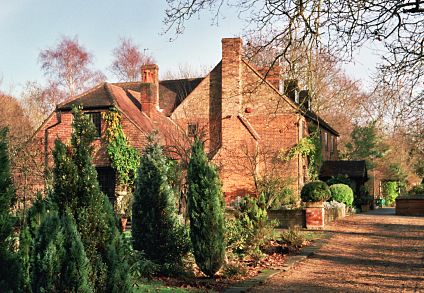
Ruislip parish workhouse, 2003.
©Peter Higginbotham.
Harefield had a parish workhouse on Breakspear Road North to the south-east of the town. The building, which appears to date from the early 18th century, has a U-shaped layout.
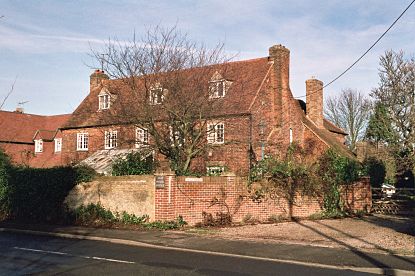
Harefield parish workhouse, 2003.
©Peter Higginbotham.
There was a workhouse on Featherstone Road, Southall Green in the parish of Norwood from 1803 until its final closure in 1839. There were 12 inmates in 1803.
Also by 1803, Hayes had acquired a workhouse on the south side of Botwell Lane. The establishment usually had about twenty-four inmates. The old men worked in the garden and women in the house.
After 1834
Uxbridge Poor Law Union formally came into existence on 20th June 1836. Its operation was overseen by an elected Board of Guardians, 20 in number, representing its 10 constituent parishes as listed below (figures in brackets indicate number of Guardians where this was more than one):
Middlesex:
Cowley, West Drayton, Harefield (2), Hayes (2), Hillingdon (3), Ickenham, Northolt, Norwood (2), Ruislip (2), Uxbridge (5).
Later addition (from 1896): Yiewsley.
The population falling in the Union in 1831 had been 12,663 with parishes ranging in size from Ickenham (297) to Uxbridge itself (3,842). The average poor-rate expenditure for 1833-5 had been £8,671 or 13s.8d. per head of the population.
The new union bought existing Hillingdon parish workhouse site for £300, together with a further four acres of land costing £600. The new workhouse building was designed by William Thorold and was built by Mr Henry Morton of Uxbridge at a cost of £4,460. Part of the old parish workhouse was converted into an infirmary block for the new establishment. A workhouse chapel was added in 1875 and other buildings including a female infirmary in 1907. The location and layout of the workhouse are shown on the 1895 map below.
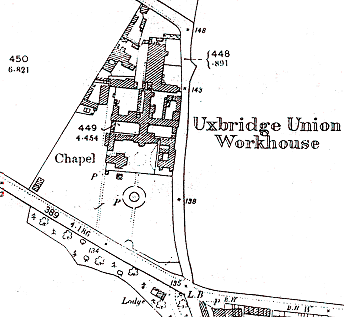
Uxbridge workhouse site, 1895.
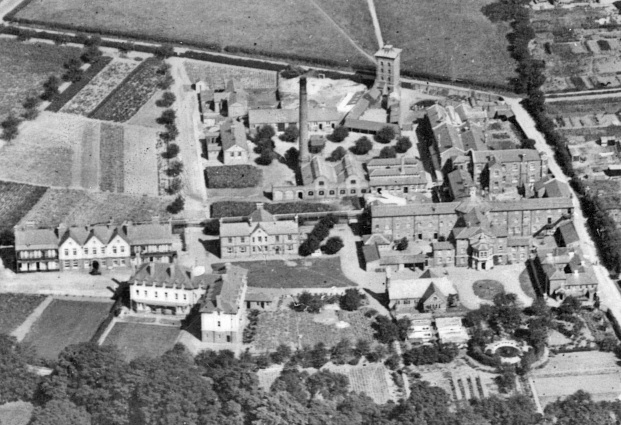
Uxbridge aerial view from the south-west.
Courtesy Howard Wingfield.
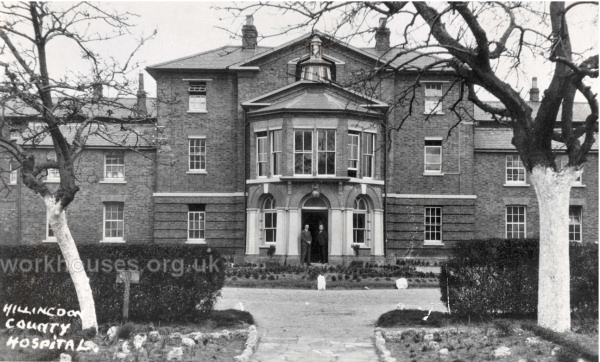
Uxbridge entrance block.
Courtesy Howard Wingfield.
In January 1867, the workhouse was visited by Poor Law Inspector Mr. Edward Smith. He found it generally clean apart from the boys' schoolroom and the men's vagrant ward. His report also noted that:
2. The receiving wards should be devoted to their proper use exclusively.
3. The small-pox ward is ill-ventilated, and, in my opinion, unfit for the reception of such cases. I find that an innate has recently taken this disease whilst attending upon such cases. A new and proper ward should be built, and the cases kept quite separate. I am surprised to find a case not of small-pox placed with three small-pox cases. The room is too small for even three cases. It is most unfair to place other cases where the risk of contagion is so imminent.
4. There are no fever wards kept exclusively for fever cases, neither are there itch wards; at present itch cases are nixed with ordinary cases. I do not think that fever cases should be introduced into the so-called fever wards, and am of opinion that proper infectious wards for itch, fever, and small-pox respectively, should be built for the two sexes.
5. The paid nurse is, in my opinion, unable to take efficient charge of all the sick cases. She does not give each dose of stimulants on the men's side. I think that there should be a paid nurse, and a paid assistant nurse, and that they should give each dose of medicines and stimulants. The present nurse has no separate bed-room or sitting room, but sleeps in one of the wards. I have pointed out a little room, on the upper floor, which might be appropriated to her use, and certainly it is most unusual that a nurse should not have a private room. The salary is only 10l. per year, a sum which is surely most inadequate if she is capable of properly discharging her duties.
6. The present fever ward should be restored to its old use as a day-room for the sick, and be properly fitted up with chairs, and benches with backs.
7. The position of the water-closets in the wards is very objectionable. It would cost little to build a projection on each side of the infirmary in which they could be placed, and have cross draughts.
8. Not more than four beds should be in the lying-ill wards.
9. There is not sufficient room on the men's side, neither in the body of the workhouse, nor in the infirmary. And the beds in many of the wards are too close together. If proper infectious wards were built, it would relieve the infirmary.
10. The women should not sleep two in a bed, and there are plenty of beds to allow them to sleep single. The flock is lumpy, and should be carded.
11. I find the sick children in various wards in the infirmary. It would be better to appropriate one ward as a sick nursery.
12. The boys' school-room is too small, and a day-room should be provided for each sex.
13. None should wash in troughs. Iron-enamelled basins should be provided.
14. Hannah Henley, aged 71, complains that she has not enough to eat, and an old man states that he has not sufficient clothing at night; the latter had only two old blankets. I suggest the desirability of purchasing good blankets, such as the matron showed to me, and rugs like horse-rugs, which would be warmer, and retain their good appearance for many years. It would be better to supply the girls with woollen dresses in winter.
15. The vagrant wards are damp, and there is not a stove in them. Hot-water pipes, or stoves, should be provided.
16. The room adjoining the chapel is much too full. If by any means a separate chapel could be built, it would give a good room where it is much wanted.
In 1930, control of the workhouse passed to Middlesex County Council who began to develop it as Hillingdon County Hospital and Infirmary. In 1963, construction began of a new Hillingdon Hospital on the south side of Heath Road. The original workhouse buildings have now been demolished but a late nineteenth century administrative block, nurses' home and laundry still survived in 2001.
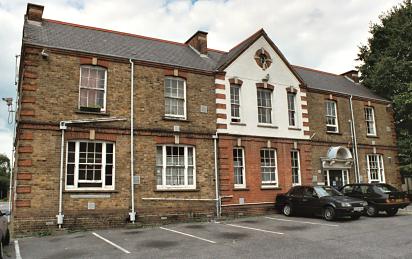
Uxbridge administrative block from the south, 2001.
©Peter Higginbotham.
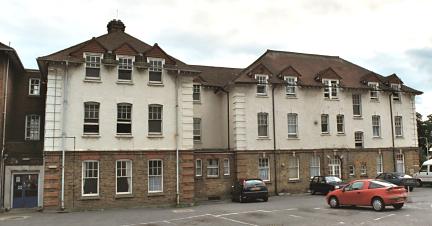
Uxbridge nurses' home from the north, 2001.
©Peter Higginbotham.
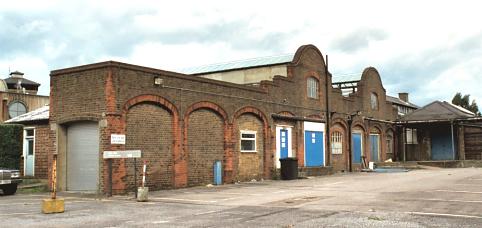
Uxbridge laundry block from the south-west, 2001.
©Peter Higginbotham.
A further redevelopment of the former workhouse site is planned.
Children's Home
By the early 1920s, the Uxbridge Union was operating two children's homes in Yiewsley, known as Tavistock Villa and Wycombe House, having a combined capacity of 30 places. By 1929, these had been replaced by a home at Bartram Lodge, Harlington Road, Hillingdon, which again provided 30 places.
Staff
Inmates
Bibliography
- Higginbotham, Peter Workhouses of London and the South East (2019)
- The Workhouse and Hospital at Hillingdon, Middlesex, 1744-1967 by Howard Wingfield (2003). (Downloadable PDF version)
Records
Note: many repositories impose a closure period of up to 100 years for records identifying individuals. Before travelling a long distance, always check that the records you want to consult will be available.
-
The
Ancestry UK
website has two collections of London workhouse records (both name searchable):
- Westminster workhouse records are available on FindMyPast, .
- London Metropolitan Archives, 40 Northampton Road, London EC1R OHB. Holdings include: Guardians' minutes (1836-1930); Admissions and discharges (1864-78); Staff records (1885-1930).
Links
Unless otherwise indicated, this page () is copyright Peter Higginbotham. Contents may not be reproduced without permission.


